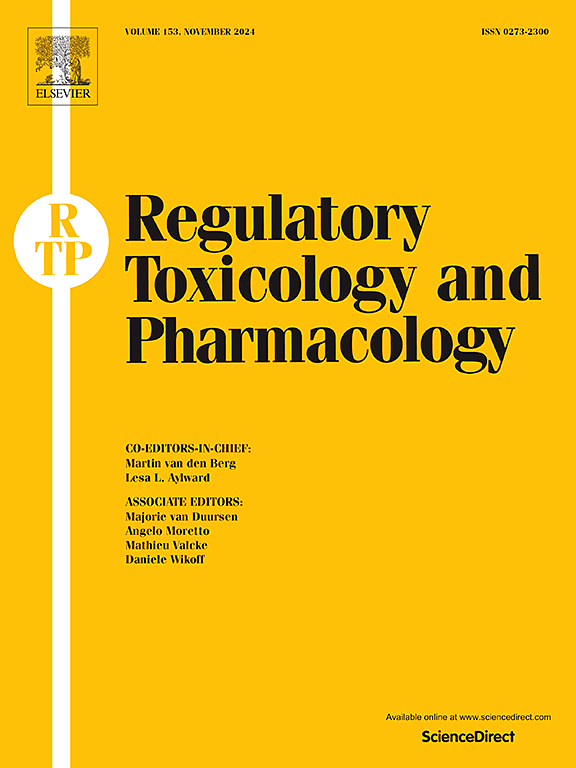发育和生殖毒理学(DART)研究的剂量水平选择:来自EUROTOX 2024卫星研讨会的见解。
IF 3.5
4区 医学
Q1 MEDICINE, LEGAL
引用次数: 0
摘要
2022年,欧洲化学品管理局(ECHA)发布了关于发育和生殖毒性(DART)研究的高剂量选择的最新建议,旨在确保在确定生殖危害的同时,不会对试验动物造成过度毒性或严重痛苦。然而,这一建议遭到了科学界的批评,他们担心动物福利和不必要的高剂量使用。为了更好地了解该建议的背景并探索该指南的影响,与ECHA合作,在哥本哈根EUROTOX 2024举办了一个卫星研讨会,汇集了来自行业,监管机构,学术界和合同研究组织(cro)的120多个全球利益相关者。讨论的重点是经合组织测试指南(TGs 414、421/422和443)中建议的解释和应用,强调了不确定性领域,如剂量间隔、性别特异性敏感性和生育与发育终点的平衡。互动式会议揭示了不同的解释,并强调需要更明确的指导。研讨会促进了相互理解,并确定了改进建议的机会,以更好地协调科学、监管和动物福利目标。本报告总结了主要讨论并概述了继续合作的必要性,以支持既支持人类健康保护又支持3Rs原则的统一的、科学合理的剂量选择做法。本文章由计算机程序翻译,如有差异,请以英文原文为准。
Dose level selection for developmental and reproductive toxicology (DART) studies: Insights from the EUROTOX 2024 satellite workshop
In 2022, the European Chemicals Agency (ECHA) issued updated advice on high-dose selection for developmental and reproductive toxicity (DART) studies, aiming to ensure reproductive hazards are identified without causing excessive toxicity or severe suffering in test animals. However, the advice faced much criticism from the scientific community with concerns around animal welfare and use of unnecessarily high doses. To better understand the background to the advice and explore the implications of this guidance, a satellite workshop was held at EUROTOX 2024 in Copenhagen, in collaboration with ECHA, that brought together over 120 global stakeholders from industry, regulatory bodies, academia, and contract research organisations. Discussions focused on the interpretation and application of the advice across OECD test guidelines (TGs 414, 421/422, and 443), highlighting areas of uncertainty, such as dose spacing, sex-specific sensitivity, and balancing fertility versus developmental endpoints. Interactive sessions revealed differing interpretations and underscored the need for clearer guidance. The workshop fostered mutual understanding and identified opportunities to refine the advice to better align scientific, regulatory, and animal welfare objectives. This report summarises key discussions and outlines the need for continued collaboration to support harmonised, scientifically justified dose selection practices that support both human health protection and 3Rs principles
求助全文
通过发布文献求助,成功后即可免费获取论文全文。
去求助
来源期刊
CiteScore
6.70
自引率
8.80%
发文量
147
审稿时长
58 days
期刊介绍:
Regulatory Toxicology and Pharmacology publishes peer reviewed articles that involve the generation, evaluation, and interpretation of experimental animal and human data that are of direct importance and relevance for regulatory authorities with respect to toxicological and pharmacological regulations in society. All peer-reviewed articles that are published should be devoted to improve the protection of human health and environment. Reviews and discussions are welcomed that address legal and/or regulatory decisions with respect to risk assessment and management of toxicological and pharmacological compounds on a scientific basis. It addresses an international readership of scientists, risk assessors and managers, and other professionals active in the field of human and environmental health.
Types of peer-reviewed articles published:
-Original research articles of relevance for regulatory aspects covering aspects including, but not limited to:
1.Factors influencing human sensitivity
2.Exposure science related to risk assessment
3.Alternative toxicological test methods
4.Frameworks for evaluation and integration of data in regulatory evaluations
5.Harmonization across regulatory agencies
6.Read-across methods and evaluations
-Contemporary Reviews on policy related Research issues
-Letters to the Editor
-Guest Editorials (by Invitation)

 求助内容:
求助内容: 应助结果提醒方式:
应助结果提醒方式:


